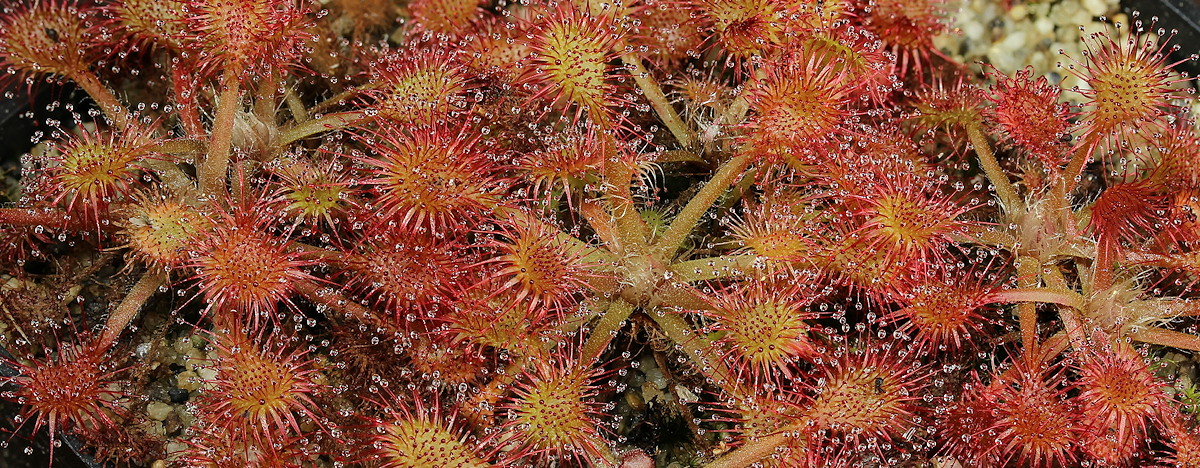
Tetraploid Drosera eloisiana, a fertile hybrid between Drosera rotundifolia and Drosera intermedia with doubled chromosomes.
Hybridization between species is common in plants. Study any flora and you will find hybrids. Verne Grant in his classic book Plant Speciation says during his study of the western North American flora he gained the impression that "hybrid semispecies are often more common than well-defined biological species". And this is not counting asexually reproducing hybrids he refers to as microspecies. Even within genera of carnivorous plants we can make make similar statements.
Among carnivorous plants there are genera where every species is interfertile with all the others. In the wild, hybrids are found where different species grow near each other. With Nepenthes species in captivity we can produce thousands of different interspecific hybrids. Intercrossing those hybrids or crossing or backcrossing to full species we can produce millions of combinations of new Nepenthes hybrids. In Sarracenia and Heliamphora, the numbers of possible simple hybrids are merely in the dozens and complex hybrids in hundreds. However, at least with Sarracenia, the large amount of color variation and form within species allows seemingly endless new hybrid types.
In the carnivorous plant genera Drosera, Pinguicula, and Utricularia there are a lot of species but the situation with respect to hybrids is more complicated. In these genera only "closely related" species can interbreed (where "closely related" is defined as being able to interbreed). Here we will concentrate on Drosera hybrids but the concepts apply to plants in general.
What is a species?
Before we can talk about hybrids we need to talk about definitions of species. This is a very difficult issue because "species" is a human concept. Humans want to define and name things in their environment. This is very natural to us because in order to talk about things we need names and we need definitions. However as much as we would like it to be, the natural world is not neat and tidy. We want there to be species but that does not mean there really are species in the sense we want there to be.
It is not as if the concept of a species is bogus. The distribution of life form types is generally discontinuous and we can use the gaps as boundaries between species. The gaps between "species" are usually quite distinct in animals and many plants but there are lots of examples in plants were one type intergrades into the next or they would if given the opportunity. This conflict between human expectations and reality has resulted in numerous species definitions. In general they all boil down to three: taxonomic species, biological species, and evolutionary species.
The taxonomic species concept has its roots in human creation stories with the basic idea being specific types were created. As we discover those types they are officially established by name with a type specimen deposited in a museum and a description published in a book, journal, or paper. There are elaborate rules about what constitutes a type and the precedence of names in case multiple specimens of the same type are registered. In general each type must be distinguishable from all other types in a dried, pressed specimen on a herbarium sheet and the published description must outline how to tell the described species from other similar species. Location and other ecological information may be recorded and described but it is irrelevant to specific status.
The rules of taxonomy recognize that hybrids do happen and hybrids between species are named at species rank. However these "nothospecies" are treated differently from full species. Nothospecies are catchalls for any and all hybrids involving two species. If there is any evidence a species arose by hybridization some taxonomists demote full species to nothospecies. Add a third species to the mix and there are no guidelines. In some ways this makes sense given the huge number of possible and actual hybrids which would cause taxonomy to devolve into a hybrid registry. Formal taxonomy also can not deal with cryptic species, that is species that can not be distinguished in dried specimens, and formal taxonomy can not deal with species that intergrade with each other in the wild producing a continuum of types.
The biological species concept has its origins in modern evolutionary and ecological theory and recognizes that individual species do not exist independent of other species or progenitors. In its purest form a species is defined as a group of interbreeding or potentially interbreeding individuals which are reproductively isolated from other such groups. This definition of a species is not very satisfactory, especially for plants. Under this definition it could be argued there is only one species each of Sarracenia, Heliamphora, and Nepenthes.
Ecologists tend to use a modified version of the biological species concept that takes into account the environment where the species live. The definition of a species could use information such as whether the plants interbreed with relatives that live in adjacent habitats and whether interbreeding between distant plants would result in a plant with same ecological adaptations. Or a species definition could ignore the issue of interbreeding entirely.
Hybrids are a real problem for the biological species concept. Just because you do not find evidence of interbreeding between species in nature that does not mean it is not happening. There are many examples of closely related species living in adjacent habitats with no hybrids found in nature. But if the two species are grown in an arboretum, effective hybridization does occur. In nature the hybrids may happen but not survive because they are adapted to an environment that does not exist at that location. Put plants in another environment and we do see hybrids. Do we consider these hybrids new species? There are cases where each individual hybrid found in a human-modified habitat is sufficiently different from the parents and the other individual hybrids they could be and have been described as species.
The major conflict related to the biological species concept and formal taxonomy is that ecologists have one idea of what constitutes a species and taxonomists have another. However, the only official way to name species is via the taxonomy route. Ecologists understand and expect hybrids, species of hybrid origin, and introgression between species. Ecologists need names to label the units they are working with in the field. To them the units are different. In many cases to taxonomists the units are not different.
Another approach has been called the evolutionary species concept. It is lineage based. The initial version of this concept relied on observing whole populations to determine a role in a biological community and how that relates to similar lineages. Before the advent of DNA sequencing, this approach was much too complicated and dependent on individual judgement.
Today the evolutionary species concept has evolved to have a molecular evolution approach where members of a species and species relationships to each other are determined from DNA sequence data. In plants we can get sequence data from the nuclear genome and from the cellular plastids: chloroplasts and mitochondria. Since the nuclear and plastid chromosomes evolve and are inherited differently it is important to study both kinds of sequence data when we are dealing with species that are potentially hybrids. Also when we are studying very closely related species it is necessary to have more sequence data, data from genetic locations that change at high rates, and data from multiple individuals across the range of the species. Closely related species usually share polymorphisms and under-sampling will give misleading results.
Many taxonomists are starting to use molecular biology and the evolutionary species concept to help define taxonomic species. It is possible in the future the field of taxonomy will shift to be able to deal with the complexities of the natural world as the importance of hybrids in evolution is better understood.
What we are left with after the dust settles on the species concept arguments is we need the rules of taxonomy with all the trappings to have something concrete to point to so we know exactly what we are talking about. But we also need to understand that it is impossible for formal taxonomy to adequately classify the actual state of affairs in nature. There are just too many things that can happen to produce separate biological/evolutionary species. With hybridization and introgression there may ultimately be no obvious way to draw lines of distinction and thus no obvious way to name everything in a simple manner.
Producing hybrids
If you are not familiar with flower structure please review the information on Wikipedia: Flowers or refresh your memory with the image of a Drosera collinsiae flower to the right. The male part of the flower consists of stamens with anthers at the tip. Pollen is produced in the anthers. The female part of the flower consists of the ovary where the seeds are produced with the style and stigmas on the top. Pollen needs to be transferred from the anthers to the stigmas. The pollen "germinates" on the stigmas and grows down the inside of style to ovules in the ovary. The ovules become seeds. In Drosera there is a lot of variation in the exact structure of the stamens and styles but they all work the same way, mostly...
Some species of Drosera have pollen self-incompatibility. In species with pollen self-incompatibility (SI), pollen from any given plant is not able to fertilize its own ovules or those of other individuals that have the same SI genotype because the pollen dies or is killed in the style. This system promotes outcrossing. If you want to collect seeds from a species with self-incompatibility you need two unrelated clones and you need to usually hand pollinate the flowers transferring pollen from the stamens in the flowers of one plant to the stigmas in the flower of the other plant. Or in species like Drosera binata, you can pollinate SI varieties with pollen from non-SI varieties. Generally plants with self-incompatibility open their flowers multiple days. Please see the page on Drosera pollen self-incompatibility for more information and a species list.
Some species of Drosera are dichogamous. That is within any given flower the stigmas are receptive at a different time from when the pollen is matured and released. These flowers are usually open for two days with the stigmas being receptive one day and the stamens releasing pollen on the other day. The order that pollen matures and the stigmas being receptive can happen in either order.
Generally to produce hybrids the best method requires removing the stamens in a flower before they mature in species that are capable of self pollination. Failure to do this can result in few if any hybrids. This can be tricky because Drosera species that typically self-pollinate may open their flowers for only a few hours. However if the flowers naturally self-pollinate they do it as the flower closes.
Drosera flowers are usually very small. To make crosses I find it easiest to use a pair of needle point forceps to pluck stamens from one flower and then paint the pollen from the anther onto the stigmas of another flower. If you get any seeds it is best to plant them immediately. However with temperate and other species with a strong seasonal life cycle it is best to plant the seeds at the appropriate time so any hybrids do not die trying to go dormant prematurely.
Hybrid Characteristics
What do we expect in hybrids? Typically hybrids display characters intermediate between the parents. This is especially true for traits involving dimensions, weight, or numbers. For these traits the hybrids tend to be half way between the parents. For traits involving structure, shape, or orientation it is more likely that the hybrid could be more like one of the parents compared to the other. These are general rules based on observations and quantitative genetics.
If you compare the leaves of Drosera x hybrida with those of its parents you can see the leaves in general are intermediate between the parents but there are certain metrics which make the hybrid leaves look more like short Drosera filiformis leaves than they look like long leaves from Drosera intermedia. On the other hand, the flowers of Drosera x hybrida are definitely more like Drosera intermedia in size and color. There is also a lot of variation between clones of Drosera x hybrida. The plant can be more or less vigorous, they may react differently to environmental factors affecting dormancy and flowering, and flower colors can range from pure white to pale pink.
Another hybrid, Drosera x eloisiana shows some unexpected features. These hybrids tend to be larger and more robust than either of the parents, Drosera rotundifolia and Drosera intermedia. This is called hybrid vigor. It is unclear whether hybrid vigor results from dominant factors overriding deleterious genes, whether developmental programs for optimized plant size are disrupted in hybrids, or both to some degree.
Hybrid names
Naming hybrids presents a serious dilemma. On the one hand there are taxonomic rules related to naming interspecific hybrids but on the other hand hybrids and especially virtually sterile hybrids are transient in nature. In cases where the hybrids are regularly found in nature or where they have entered cultivation it is nice to have a simple name. In cases where an allopolyploid species and its progenitor hybrids and backcrosses exist the situation is difficult taxonomically.
The International Code of Botanical Nomenclature provides for a mechanism to name hybrids. The hybrids are considered to be at the same rank as species and are referred to as nothospecies. Nothospecies are described and names reserved just like full-fledged species. An "x" is added between the genus and species names to indicate the name is a nothospecies. Thus the hybrid between Drosera rotundifolia and Drosera intermedia has been described and named Drosera x eloisiana. According to the rules any and all hybrids involving those two species get the same name. The hybrid (Drosera x eloisiana) x D. rotundifolia would also be referred to as Drosera x eloisiana as well as the fertile allotetraploid produced from Drosera x eloisiana. For taxonomists it keeps the situation tenable. Describing each new combination as a new nothospecies would lead to chaos. Some authors define the new combinations as subspecies but Schlauer (2010) ( PDF ) recommends the use of variety.
Under the ICBN rules, the use of an "x" in a hybrid name is optional. Schnell (1999) ( PDF ) argued for the use of "x" to indicate sterile homoploid hybrids and the lack of the "x" with the same species/nothospecies name to indicate fertile polyploids. This naming convention is not consistent with the ICBN rules.
International Code of Nomenclature for Cultivated Plants is a separate set of rules dealing with cultivar names. The ICPS is the International Registration Authority for carnivorous plant cultivars under this code. Anyone can give a cultivar name to any plant irrespective of its heritage. Drosera ‘Ivan’s Paddle’ is an example of a cultivar name. The plant is a hybrid between an artificial tetraploid Drosera rotundifolia and Drosera anglica. Naming the plant this way avoids any discussion as to whether it would be appropriate to call it Drosera x obovata or something else. Another way to use this system is to identify specific hybrid clones. Drosera x eloisiana 'Nightmare' is a specific, vigorous clone that was found in the wild.
Fertile hybrids within species
It is necessary to have characters to follow such as flower color or leaf color or shape to know a cross to produce a hybrid was successful. There are Drosera species that are variable across their range. These variations can occur because there is so little gene flow between disjunct populations and local conditions such as pollinator color preferences can have strong selective effects.
Ivan Snyder did a three-way cross of Drosera spatulata varieties from Australia. The first cross was typical Drosera spatulata, Wentworth Falls, Blue Mountains, with white flowers by D. spatulata var. gympiensis, Gympie, with pink flowers and short hairy peduncles and sepals. The first generation hybrids had pink flowers and a mix of short and long peduncles and hairy and almost glabrous peduncles and sepals. One of these offspring was then crossed to D. spatulata, Woronora River, Sydney, with pink flowers. The immediate offspring had pink flowers. Subsequent generations had either white or pink flowers, long or short peduncles, and hairy or glabrous peduncles and sepals.
Another example of within species hybrid is the cross between the California and Hawaii Drosera anglica. The California form is robust but strongly temperate. It is difficult to grow under lights or in mild climate regions. The Hawaii form does not form hibernacula but under warm conditions tends to be weak. The hybrids between the two were intermediate in robustness grown indoors and Ivan Snyder selected ones that grew well under lights and in mild climate regions. The selected hybrids do not survive conditions normal to the California form.
Sterile hybrids within species
In general we expect within species hybrids to be fully viable and fertile. If crosses within a taxonomic species are not fully viable and fertile the parents are really cryptic species or different biological species. The best example of this is a species with chromosomal races like Drosera spatulata. Most populations of Drosera spatulata in New Zealand are diploid with 20 chromosomes. The non-diploid populations in New Zealand are tetraploid with 40 chromosomes. All other populations of this very widespread species are also tetraploid as far as we know. Any hybrids between diploid and tetraploid plants will produce virtually sterile triploids.
Within species there can be genetic and epigenetic incompatibilities between distant populations. An example of this that needs to be confirmed and studied in more detail is Ivan Snyder's cross between Louisiana and North Carolina Drosera brevifolia. He reported that the hybrid did not produce viable pollen. Generally male sterility alone is more common than female sterility where ovules fail to form properly. And male sterility is observed within species irrespective of obvious hybrid status. So if Ivan's result is confirmed it would be interesting to determine the genetic basis of the sterility.
Fertile hybrids between closely related species
Some people might argue that if two species can interbreed and produce fully viable and fertile hybrids they are the same species irrespective of taxonomic characters. I suppose it depends on what taxonomic characters and how many. However the existence of fixed differences between the species indicates they are not in fact interbreeding in nature and have not for quite some time. That they can can interbreed and produce offspring indicates that there have been few if any significant chromosomal changes since the species evolutionarily diverged.
An example of a fertile hybrid between species that have different forms is Drosera dielsiana x nidiformis. These are south African species part of a large taxonomically messy group of species. It is impossible to confuse Drosera dielsiana and Drosera nidiformis since they look very different and have very different growth habits. The hybrid vaguely looks like other species in the group. That does not mean those species are hybrids. They may represent the original type for the group.
The Drosera petiolaris group in northern Australia is not as messy taxonomically as the south African rosetted Drosera although that may only reflect the fact that fewer people have worked on the taxonomy of the group. There has been some discussion about which plants are the pure forms and which are hybrids but nothing like the south African species. However all of the perennial species within the group (i.e. not Drosera banksii) appear to be interfertile and hybrids and hybrid swarms are known in nature. It is easy to make hybrids in cultivation. In fact it is easier to make hybrids than it is to make pure species seed because the flowers are self-incompatible. In plants with self-incompatible flowers you need to have two unrelated plants blooming at the same time. Within the Drosera petiolaris group ANY unrelated plant within the group will do. Many of the artificial hybrids between the extreme forms are reminiscent of the median forms leading some people to propose a number of the species are of hybrid origin.
A pair of species that unexpectedly forms fully fertile hybrids is D. burmannii from Australia and Drosera sessilifolia from South America. It is not known how long ago the two species separated but the plants themselves are distinctly different.
Sterile hybrids between closely related species
Hybrid sterility usually results from problems with chromosome pairing during meiosis. You may recall that during normal cell division, only the two copies of the same chromosome are paired. This means that plants with an odd assortment of chromosomes can survive and grow just fine. But during meiosis where a plant is doing a reduction division to only half the normal complement of chromosomes to make pollen and ovules, homologous chromosomes must pair to assort properly. If the chromosomes can not pair properly the resultant pollen and ovules will not have a proper set of chromosomes. The reason I say some plants are virtually sterile is with a very low probability these plants will make a pollen grain or ovule with a normal chromosome complement.
There can be other reasons for sterility in hybrids including any number of random genetic incompatibilities as well as issues with the epigenome and transposable elements. The Drosera Chromosomes page covers chromosomal causes of sterility in hybrids in detail.
Examples of vigorous, virtually sterile interspecies hybrids between species with the same number of chromosomes include:
D. intermedia x capillaris
D. intermedia x filiformis
D. intermedia x rotundifolia
D. rotundifolia x linearis
All of these have been found in the wild with D. intermedia x rotundifolia and D. rotundifolia x linearis being quite common where the two species grow together. Additional combinations of those species have been created artificially.
Hybrids found in nature between species with different chromosome numbers include:
D. anglica x rotundifolia
D. rotundifolia x tokaiensis
D. rotundifolia x spatulata
All of these hybrids could eventually form new species via allopolyploidy if they have not already.
Hybrids that do not happen or do not survive
At some point different species diverge to the point where not only do the chromosomes not pair properly in meiosis, but also their chromosomes are so toxic to each other that they can not produce fully viable offspring. There are the cases where a cross produces what appear to be good seeds but we get failure of germination or the seedlings die. Examples of these hybrids include some fairly distant relatives. For instance the hybrids Drosera montana (a South American tetraploid) x Drosera brevifolia (a North American diploid) and Drosera brevifolia x Drosera aliciae (a south African tetraploid) have been reported to make weak offspring that do not survive to maturity.
For crosses where we get no seeds, there are a plethora of possibilities as to the causes. Besides basic genetic / chromosomal / transposable element causes explained on the Drosera Chromosomes page, there can be pollen incompatibility where the pollen fails to germinate on the stigma, pollen is killed in the style, pollen dies before reaching the ovules, pollen can not effectively fertilize the ovules, and so on. Sometimes we get hybrid failure between relatively close relatives like Drosera capensis x Drosera dielsiana and Drosera spatulata x Drosera montana but usually the plants must be more distant.
-- John Brittnacher
January 2010
minor update January 2022
Named natural hybrids:
Drosera x anglica* = D. rotundifolia x linearis
Drosera x badgerupii = D. occidentalis x nitidula
Drosera x eloisiana = D. rotundifolia x intermedia
Drosera x californica = D. filiformis x tracyi
Drosera x corinthiaca = D. aliciae x glabripes
Drosera x fontinalis = D. grantsaui x tomentosa
Drosera x hybrida = D. intermedia x filiformis
Drosera x obovata* = D. anglica x rotundifolia
Drosera x oriharaensis* = D. rotundifolia x tokaiensis
Drosera x sidjamesii = D. patens x pulchella
Drosera x tokaiensis* = D. rotundifolia x spatulata
* These names as written are not accepted by all authorities. See Schlauer (2010) ( PDF ) for more information on appropriate notation.
Other reported hybrids based on the list at Carnivorous Plant Photofinder:
Drosera affinis x madagascariensis
Drosera aliciae x neocaledonica
Drosera aliciae x slackii
Drosera anglica x filiformis
Drosera anglica x spatulata
Drosera brevifolia x intermedia
Drosera burmannii x sessilifolia
Drosera camporupestris x graminifolia
Drosera capensis x aliciae
Drosera capensis x spatulata
Drosera capillaris x intermedia
Drosera capillaris x rotundifolia
Drosera capillaris x tokaiensis
Drosera cuneifolia x ramentacea
Drosera dielsiana x coccicaulis
Drosera dielsiana x nidiformis
Drosera elongata x affinis
Drosera esterhuyseniae x capensis
Drosera esterhuyseniae x slackii
Drosera filiformis x rotundifolia
Drosera glabipres x venusta
Drosera glabripes x aliciae
Drosera graminifolia x montana tomentosa
Drosera graomogolensis x montana tomentosa glabrata
Drosera hirtella hirtella x hirtella lutescens
Drosera hirtella lutescens x communis
Drosera intermedia Mt. Roraima Venezuela x tokaiensis
Drosera intermedia x anglica
Drosera intermedia x brevifolia
Drosera intermedia x capillaris
Drosera intermedia x linearis
Drosera intermedia x montana
Drosera linearis x (filiformis x tracyi)
Drosera linearis x spatulata
Drosera montana schwackei x montana tomentosa
Drosera montana tomentosa x grantsaui
Drosera neocaledonica x aliciae
Drosera neocaledonica x oblanceolata
Drosera nidiformis x (dielsiana x nidiformis)
Drosera nidiformis x dielsiana
Drosera nidiformis x venusta
Drosera oblanceolata x capillaris
Drosera oblanceolata x spatulata NZ
Drosera occidentalis x pulchella
Drosera quartzicola x chrysolepis
Drosera rotundifolia x anglica
Drosera rotundifolia x capillaris
Drosera rotundifolia x linearis
Drosera rotundifolia x spatulata
Drosera slackii x capensis
Drosera spatulata x (anglica x spatulata)
Drosera spatulata x anglica
Drosera spatulata x capensis
Drosera spatulata x linearis
Drosera spiralis x montana tomentosa
Drosera tokaiensis x capensis
Drosera tokaiensis x capillaris
Drosera tokaiensis x rotundifolia
Drosera tracyi x intermedia
Drosera venusta x capensis
Drosera villosa ascendens x montana schwackei
Drosera villosa ascendens x montana tomentosa
Drosera villosa ascendens x villosa
Drosera villosa x montana tomentosa
Drosera macrantha x andersoniana
Drosera allantostigma x omissa
Drosera callistos x lasiantha
Drosera echinoblastus x omissa
Drosera helodes x pulchella
Drosera lasiantha x omissa
Drosera nitidula nitidula x occidentalis occidentalis
Drosera nitidula nitidula x pygmaea
Drosera nitidula x allantostigma
Drosera nitidula x occidentalis
Drosera nitidula x omissa
Drosera nitidula x pulchella
Drosera omissa x allantostigma
Drosera omissa x echinoblastus
Drosera omissa x nitidula
Drosera omissa x pulchella
Drosera patens x occidentalis occidentalis
Drosera pulchella x allantostigma
Drosera pulchella x nitidula
Drosera pulchella x nitidula
Drosera pulchella x occidentalis
Drosera pulchella x omissa
Drosera pulchella x patens
Drosera pygmae x nitidula
Drosera mannii x omissa
Drosera broomensis x ordensis
Drosera caduca x falconeri
Drosera caduca x ordensis
Drosera darwinensis x falconeri
Drosera darwinensis x kenneallyi
Drosera dilatopetiolaris x ordensis
Drosera falconeri x aff. ordensis
Drosera falconeri x darwinensis
Drosera falconeri x lanata
Drosera falconeri x paradoxa
Drosera falconeri x petiolaris
Drosera fulva x ordensis
Drosera fulva x paradoxa
Drosera kenneallyi x lanata
Drosera lanata x broomensis
Drosera (lanata x broomensis) x ordensis
Drosera lanata x dilatatopetiolaris
Drosera lanata x kenneallyi
Drosera lanata x ordenensis
Drosera lanata x paradoxa
Drosera lanata x petiolaris
Drosera ordensis x falconeri
Drosera (ordensis x falconeri) x darwinensis
Drosera (ordensis x falconeri) x petiolaris
Drosera ordensis x paradoxa
Drosera paradoxa x broomensis
Drosera paradoxa x ordensis
Drosera petiolaris x kenneallyi
Drosera petiolaris x ordensis
Drosera petiolaris x paradoxa
For more information please see:
Grant, Verne (1981) Plant Speciation. Columbia University Press, NY. https://doi.org/10.7312/gran92318
The reference book for botanists and primary source for technical details on this page.
Gottlieb, L. D. (1984) Genetics and Morphological Evolution in Plants. The American Naturalist 123(5):681-709. https://doi.org/10.1086/284231
A review of the genetic control of plant traits using hybrids.
Wood, C. E. (1955) Evidence for the hybrid origin of Drosera anglica. Rhodora 57: 105-130.
Kusakabe, Isamu (1979) Japanese Drosera Hybrids. Carniv. Pl. Newslett. 8(2):54. (PDF)
Sheridan, Philip (1987) A Preliminary Report on Drosera intermedia x D. capillaris. Carniv. Pl. Newslett. 16(3):71-73. (PDF)
Drosera intermedia and Drosera capillaris have multiple forms in Florida. Now Drosera intermedia x D. capillaris hybrids have been found.
Kondo, K. and M. Segawa. (1988) A cytotaxonomic study in artificial hybrids between Drosera anglica Huds. and its certain closely related species in series Drosera, section Drosera, subgenus Drosera, Drosera. La Kromosoma II 51-52: 1697–1709.
Schnell, Donald. (1999) Drosera anglica Huds. vs. Drosera x anglica: What is the difference? Carniv. Pl. Newslett. 28(4):107-115. (PDF)
Comparison of characters delineating Drosera anglica and Drosera x anglica.
Gibson, Robert (1999) Drosera x corinthiaca (Droseraceae), a newly recognized natural hybrid from the Cape Province,South Africa. Carniv. Pl. Newslett. 28(3):81-84. (PDF)
Nakano, M., E. Kinoshita and K. Ueda. (2000) Life history traits and coexistence of an amphidiploid, Drosera tokaiensis, and its parental species, D. rotundifolia and D. spatulata (Droseraceae). Plant Species Biology 19:59–72. https://doi.org/10.1111/j.1442-1984.2004.00102.x
A study of the physical and life history traits of Drosera tokaiensis in relation to its parental species.
Snyder, Ivan (2000) Colchicine Treatment on Sterile Hybrid sundews. Carniv. Pl. Newslett. 29(1):4-10. (PDF)
Snyder, Ivan (2003) Curious Natural Hybrid Sundews. Carniv. Pl. Newslett. 32(2):52-56. (PDF)
A discussion of Drosera x obovata Drosera anglica, and Drosera intermedia x D. capillaris along with crosses and colchicine treatments.
Allen Lowrie and John G. Conran (2007) Drosera × sidjamesii (Droseraceae: systematics and ecology of a natural hybrid from Western Australia. Australian Systematic Botany 20(1): 44–53. https://doi.org/10.1071/SB04018
Rivadavia, Fernando (2009) Drosera x fontinalis (Droseraceae), the first natural sundew hybrid from South America. Carniv. Pl. Newslett. 38(4):121-125. https://doi.org/10.55360/cpn384.fr218 (PDF)
Schlauer, Jan (2010) Nomenclature of the Drosera anglica complex revisited. Carniv. Pl. Newslett. 39(2):46. https://doi.org/10.55360/cpn392.js729 (PDF)
Appropriate taxonomic naming of Drosera anglica and its related hybrids if you treat Drosera anglica itself as a hybrid rather than an independent species.
Brittnacher, John (2011) Drosera x hybrida rest in peace. Carniv. Pl. Newslett. 40(4):112-121. https://doi.org/10.55360/cpn404.jb293
History of Drosera x hybrida. (PDF)
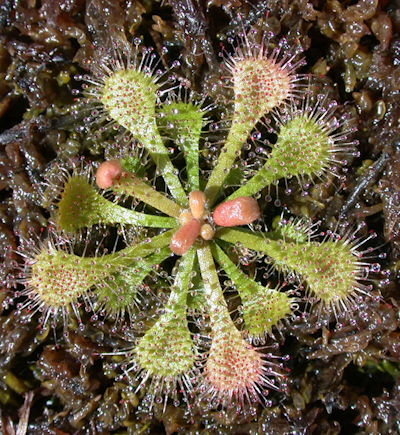
Drosera brevifolia x spatulata. Cross and photo by Ivan Snyder.
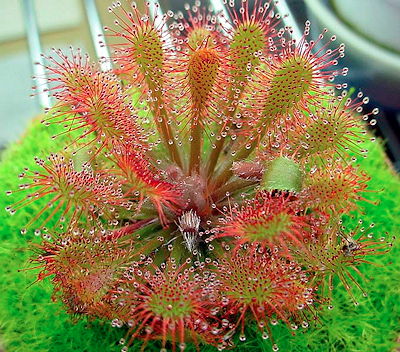
Drosera x nagamotoi, a hybrid between D. anglica and D. tokaiensis.
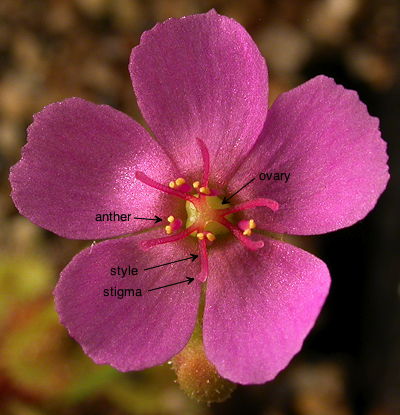
Drosera collinsiae flower. Typical Drosera flowers have 5 anthers and three styles. Drosera regia styles do not divide. Many Drosera species including Drosera collinsiae have once divided styles giving 6 stigmas. Some species have multiply divided styles giving dozens of stigmas. For seeds to be produced, pollen needs to be transferred from an anther (most Drosera pollen is yellow) to the stigmas.
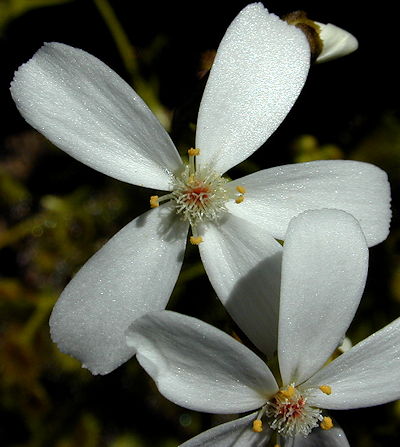
Drosera rupicola flowers showing styles that are divided very many times.
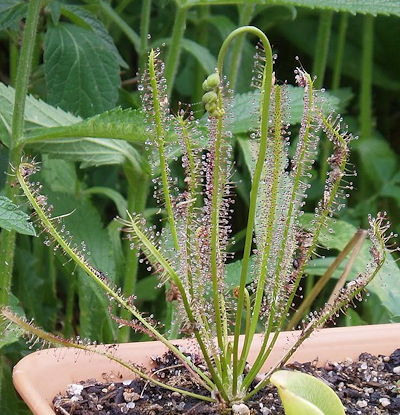
Drosera x hybrida, a natural hybrid between Drosera filiformis and Drosera intermedia found in the New Jersey pine barrens of the USA. Photo by RL7836.
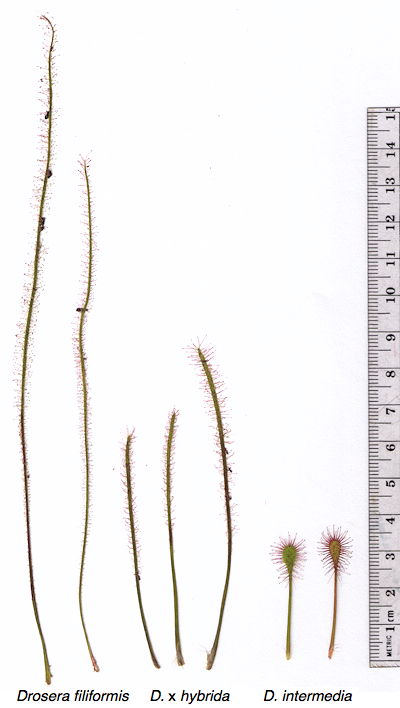
Typically hybrids will show characters intermediate between the parents. The leaves of Drosera x hybrida are intermediate between the leaves of its parents. These are pressed leaves imaged on a flat-bed scanner.
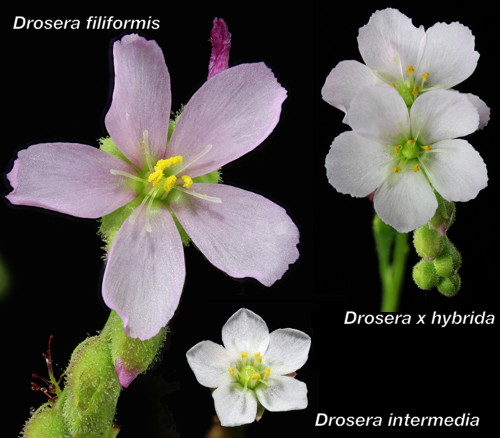
The flowers of Drosera x hybrida and its parents to scale. Drosera x hybrida flowers tend to be more like flowers of Drosera intermedia except for the styles.
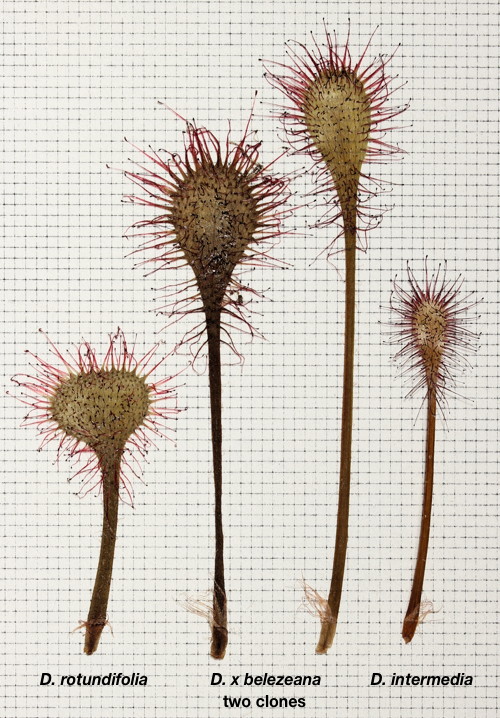
The leaves of Drosera x eloisiana (was Drosera x belezeana) tend to be larger than its parents. The Drosera x eloisiana leaf on the left is the fertile polyploid, Drosera 'Dr. Frankensnyder's Monster', on the right is Drosera 'Nightmare'. The dried leaves are on a 1 mm grid.
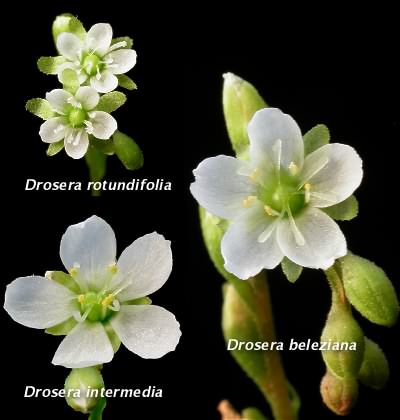
The flowers of the fertile polyploid of Drosera x eloisiana (was Drosera x belezeana) are the same size as the flowers of Drosera intermedia (9 mm) and more than twice the size of Drosera rotundifolia flowers.
Compare the structure of the Drosera eloisiana flower with its parents. A larger photo of Drosera rotundifolia is below to help see the features of that species.
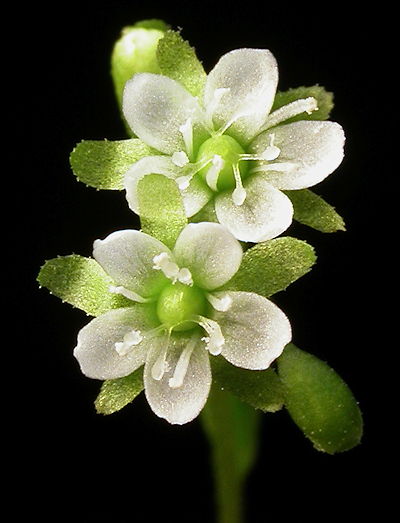
Drosera rotundifolia flowers. These flowers are 4 mm across.
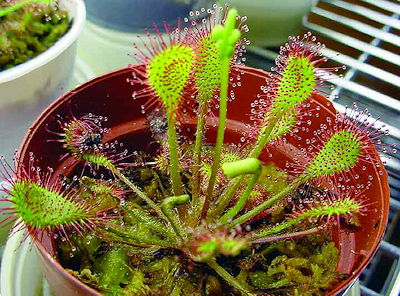
A hybrid between tetraploid Drosera rotundifolia and Drosera anglica produced by Ivan Snyder and named as the cultivar Drosera ‘Ivan’s Paddle’. Photograph by Chris Hind, grown by Forbes Conrad, Carniv. Pl. Newslett. 37(1):22-26.
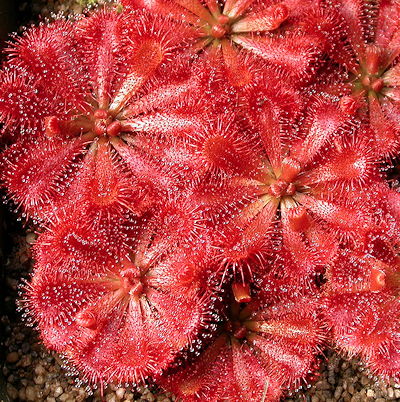
Drosera spatulata hybrid produced by Ivan Snyder. It is (Drosera spatulata, Wentworth Falls, Blue Mountains, AUS, white flowers x D. spatulata var. gympiensis, Gympie, AUS, pink flowers) x D. spatulata, Woronora River, Sydney, AUS, pink flowers. These plants can have either white or pink flowers.
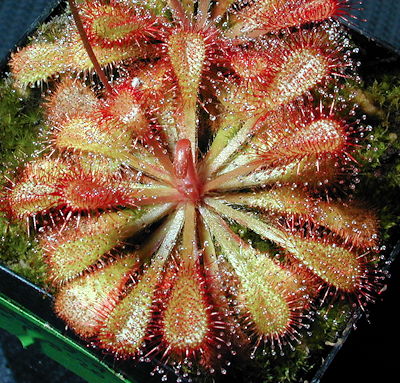
Drosera dielsiana x nidiformis.
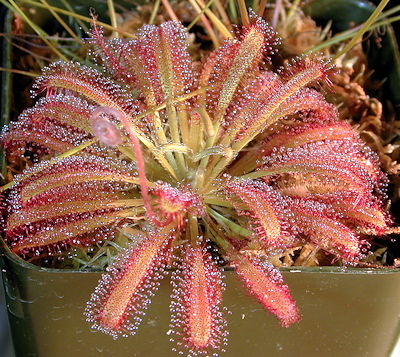
Drosera capensis x spatulata.
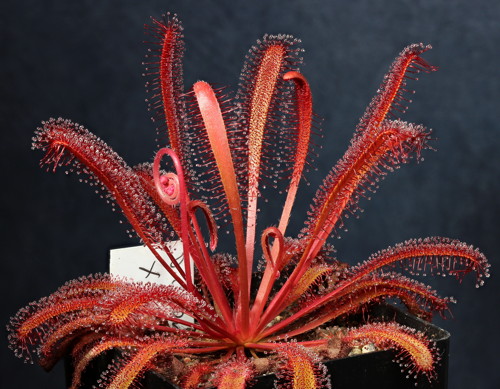
Drosera capensis "red, Gifberg Pass, South Africa" x spatulata "red, Royal National Park, Sydney, Australia" produced in 2019 by John Brittnacher. Similar clones created by others exist as well.
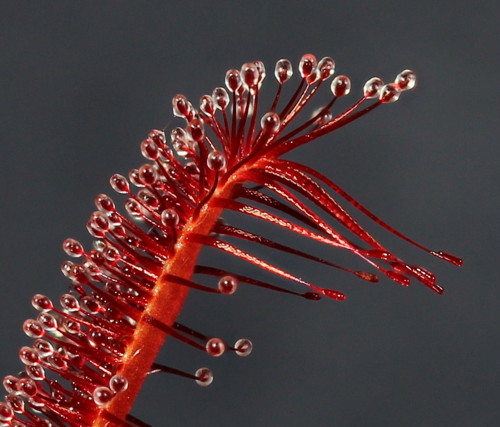
Closeup showing snap tentacles at the tips of the Drosera capensis x spatulata leaf. Snap tentacles are typically found on Drosera species with ground-hugging leaves.
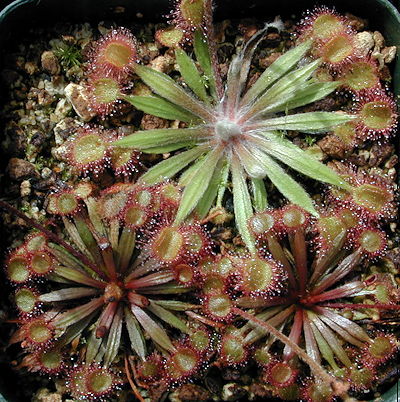
Drosera falconeri hybrids produced in cultivation.
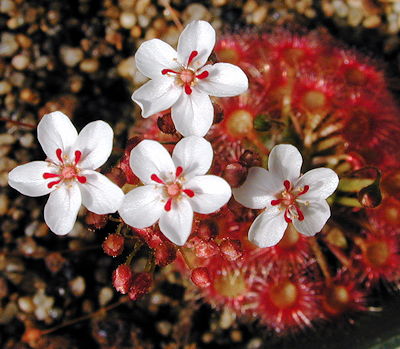
Drosera patens x occidentalis occidentalis, a natural hybrid found in Australia.
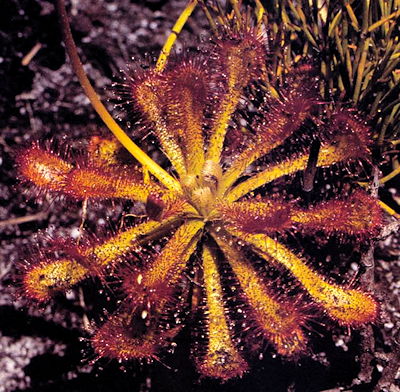
Drosera x corinthiaca, the natural hybrid between Drosera aliciae and Drosera glabripes found in South Africa. Photo by Robert Gibson, Carniv. Pl. Newslett. 28(3):81-84, 1999.
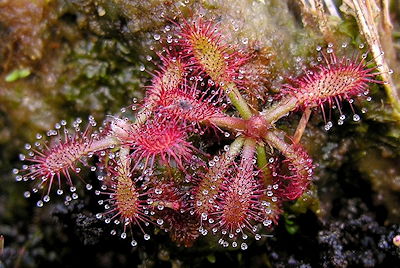
Drosera x fontinalis, the natural hybrid between Drosera grantsaui and Drosera tomentosa, Chapada dos Veadeiros, Goiás, Brazil. Photo by Fernando Rivadavia.
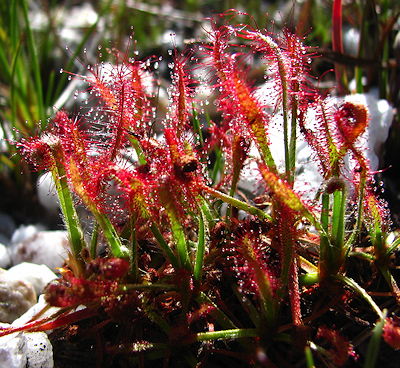
Drosera quartzicola x chrysolepis, Serra do Cipó, Minas Gerais, Brazil. Photo by Fernando Rivadavia.
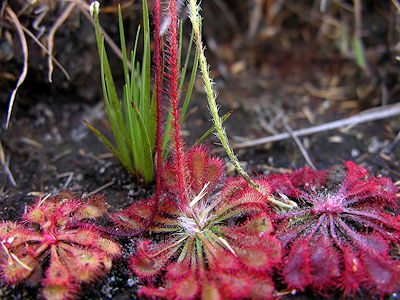
Drosera hirtella var. hirtella (left), Drosera hirtella var. hirtella x var. lutescens (center), and Drosera hirtella var. lutescens (right), Serra dos Pirineus, Goiás, Brazil. Photo by Fernando Rivadavia.
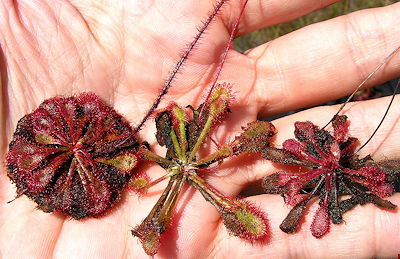
Drosera hirtella var. hirtella (left), Drosera communis x hirtella var. hirtella (center), Drosera communis (right), Chapada dos Veadeiros, Goiás, Brazil. Photo by Fernando Rivadavia.
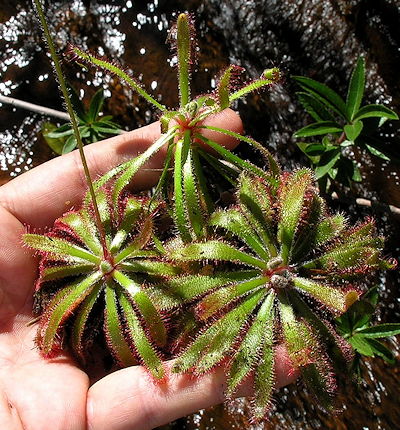
Drosera ascendens (top), Drosera ascendens x tomentosa (bottom), Diamantina, Minas Gerais, Brazil. Photo by Fernando Rivadavia.
List of crosses performed by Ivan Snyder as reported in Snyder, Ivan (2000) Colchicine Treatment on Sterile Hybrid sundews. Carniv. Pl. Newslett. 29(1):4-10 (PDF).
|
D. brevifolia x burmannii |
A |
|
D. burmannii x glanduligera |
A |
|
D. capensis x dielsiana |
A |
|
D. indica x adelae |
A |
|
D. madagascariensis x spatulata |
A |
|
D. anglica x indica |
B |
|
D. brevifolia x glanduligera |
B |
|
D. spatulata x montana |
B |
|
D. capensis x collinsae |
C |
|
D. montana x brevifolia |
C |
|
D. brevifolia x aliciae |
D |
|
D. (dielsiana x nidiformis) x spatulata |
D |
|
D. anglica x spatulata |
E |
|
D. brevifolia x rotundifolia |
E |
|
D. brevifolia x spatulata |
E |
|
D. esmeraldae x anglica |
E |
|
D. rotundifolia x anglica |
E |
|
D. rotundifolia x brevifolia |
E |
|
D. anglica x (x nagamotoi) |
F |
|
D. brevifolia --Louisiana x brevifolia --North Carolina |
F |
|
D. anglica --California x anglica --Hawaii |
G |
|
D. burmannii x sessilifolia |
G |
|
D. dielsiana x nidiformis |
G |
|
D. (dielsiana x nidiformis) x sp. Rhodesia |
G |
|
D. spatulata --typical Australian x spatulata --Gympie type |
G |
|
|
|
| A--no seed or enlarged capsule produced | |
| B--nonviable seed produced | |
| C--seed viable but seedlings died | |
| D--weak, sterile plants result | |
| E--strong, sterile hybrids made | |
| F--hybrids fertile, but with defective pollen | |
| G--healthy, fertile hybrids. |
